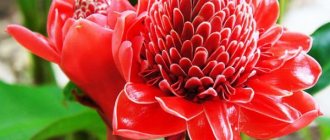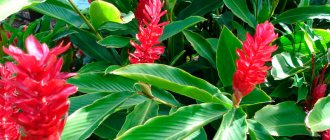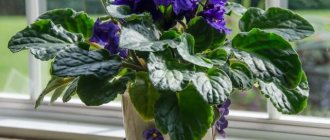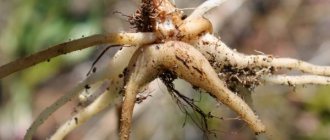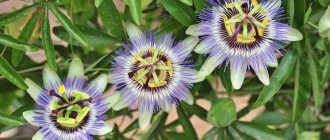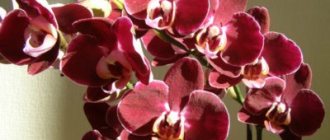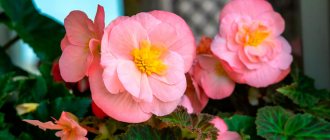Ginger as a unique spice and universal medicine has been known to mankind since ancient times. Even before the invention of medicine, this plant was successfully used to treat various ailments. This is confirmed by the mention of the plant in the holy book of Muslims, the Koran. Literally translated, ginger means “horned root,” as indicated by the shape of the rhizomes of this plant. Ginger grows in India, Japan, China, and in the regions of Central America. This is one of the very first spices that was brought to Europe from Asia.
Ginger is a plant that does not grow in the wild; it is grown on special plantations. For the first time, the inhabitants of India began cultivating ginger. In those days, traders used ginger roots as a currency, which once again confirms the undoubted value of this plant for humans.
You can read about what ginger looks like here.
After the horned root came to the Mediterranean countries and Europe, it immediately attracted the attention of scientists and culinary specialists. Ginger is mentioned in many ancient medical works, in the writings of philosophers, as well as in old culinary recipes. In addition to its medicinal and good taste qualities, ginger has been endowed with aphrodisiac abilities; for example, translated from Chinese, the name of this plant sounds like “masculinity.” More details about the use and benefits of ginger for men are written in this article.
Ginger root in ancient times was one of the most useful and expensive spices
The cost of ginger roots in those days was off the charts. Only noble people could afford to eat it. For example, Queen Elizabeth I of England was very fond of ginger bread, and King Henry VIII preferred meat dishes and vegetables seasoned with ginger, ginger wine and beer, and horned root jam.
Ginger came to our country only during the times of Kievan Rus. Then this spice was used to season baked goods, various meat and vegetable dishes, and drinks (kvass, beer, mead, etc.). It was during this period that gingerbread cookies were invented, which, because of their spicy taste, began to be called the well-known gingerbread cookies.
Unfortunately, due to the political beliefs of the country's leaders, the residents of Soviet Russia were not familiar with the taste and beneficial properties of ginger for a very long time, and ancient ginger recipes quickly began to be forgotten. The horned root again became available to residents of the Russian Federation relatively recently, but in this short time it has already managed to regain its former glory.
Today you can even buy ginger beer
Botanical description of the plant
Ginger is a herbaceous perennial plant from the Ginger family (Zingiberaceae). The stems of the plant are straight, reaching a height of 1.5 m. The stems contain lanceolate leaves and flowers from brown to orange-yellow, collected in spike-shaped inflorescences (how ginger blooms is described here). The plant has fruits and rhizomes. The fruits are not used in food. The main valuable part of the plant is the fleshy, roundish, palmately divided rhizomes, which form an entire root system.
Ginger grows in warm and humid climates. It can be cultivated not only on special plantations, but also in ordinary flower pots or boxes at home. Detailed instructions on growing ginger at home are on this page.
The plant reproduces by rhizomes. To do this, small pieces of 2-2.5 cm in size rhizomes with “eyes” are planted in the soil in March-April. The ripening period is 6-10 months, depending on climatic conditions. Dig up the plant when its foliage turns yellow and begins to fall off.
This is how ginger grows in its homeland
There are 2 types of ginger - black and white, which are essentially the same plant, but differ in the way the roots are processed.
After harvesting, black ginger (Barbados) is simply doused with boiling water, without removing the peel from the roots. After this, the roots are dried in the sun. It has a more pronounced spicy aroma and pungent taste, since less aromatic substances are lost from the product during processing.
White ginger (Bengal) is the peeled roots of the plant, which are subsequently treated with sulfuric acid or lime. After this treatment, they are thoroughly washed and dried in the sun.
The ginger pulp is the same and there are two varieties. It ranges in color from white to light yellow and yellow. The older the root, the darker its flesh. Ginger has a very specific taste - both sweet and spicy.
The fresher the ginger root, the lighter it is when cut.
Is it possible to get a harvest?
It is extremely difficult to find this plant in the wild in our latitudes. As you know, the birthplace of ginger is India, and therefore it requires special climatic conditions. Heat-loving ginger does not tolerate drafts, dampness and excessive moisture . He won't like the scorching sun either.
However, the lack of suitable climatic conditions is not at all a reason to refuse to grow ginger. With proper care, it grows both in the garden and on the windowsill. To do this, you only need to follow the rules for caring for the plant, which every Russian gardener can handle. It is grown in conditions of high temperature and humidity, in partial shade, away from drafts and direct sunlight.
For your information. Ginger grown in central Russia will differ from its southern counterparts. But it is possible to obtain roots that are quite suitable for consumption.
Is it possible to grow ginger yourself?
Anyone can grow ginger at home. To do this you need to know a few secrets:
- The plant needs to be planted in winter.
- The ideal candidate for seedlings is a root without visible damage with a smooth and glossy skin. You also need to pay attention to the presence of “eyes” at the root. The more there are, the better.
- Since ginger grows in width, the dishes should not be narrow or deep.
- The root for planting is divided into pieces of 2-2.5 cm along the so-called jumpers and planted in a container. Some experts advise treating the fault line with charcoal.
- Any soil will do, but soft and loose soil is ideal.
- The plant needs to be cultivated in a bright place until the first shoots appear. After this, it is better to put the pot of ginger in the shade.
- And do not forget to regularly water and spray the foliage with water, as this plant loves moisture very much.
If you did everything correctly, then 6-10 months after planting you will be able to harvest the first harvest.
Planting time
When is the best time to plant ginger root? According to experts, the most optimal time for planting is the end of winter - the beginning of spring.
However, do not forget that ginger is a heat-loving plant, so it is best planted in the soil in the middle zone and in the North of Russia in heated greenhouses. The required soil temperature is 12 – 15°C, and the air temperature is 25 – 30°C . The most suitable time for permanent planting in greenhouse soil is the first half of March.
But the roots “move” to open ground in April-May, when there is no threat of a recurrence of spring frosts.
How to store it correctly
There are two ways to store fresh root:
- In a refrigerator. Ginger can be stored in the refrigerator for a long time, but it will gradually lose all its healing properties. To avoid this, it is recommended to keep it in the refrigerator (lower shelves, special compartment for vegetables) for no longer than 6-7 days.
- In the freezer. If you need to preserve the plant for a long time and at the same time preserve its taste and beneficial properties, you can store it in the freezer. To do this, ginger is cut into thin rings or grated, packed in a plastic bag and smoothed into a thin plate. If you need the product, you can break off a piece of the required size from the frozen plate.
All the intricacies of storing ginger are described in detail here.
Dried ginger can be stored for a long time (several months) at room temperature, but it is important to keep it in a closed container so that the spicy smell does not dissipate.
Ginger can be found in 3 types: fresh and dried roots, crushed into dry powder
Growing area
The homeland of ginger is South Asia; it is believed that India is the country where, back in the 9th century. The plant was first used as food. It was brought to Europe in the Middle Ages as a spice.
Even then, the root was endowed with healing properties. For example, it was used to protect oneself from the plague that was raging throughout the world. In Russia, the plant appeared on sale in the 19th century.
Now ginger grows over vast areas:
- West Africa;
- Indonesia;
- China;
- Australia;
- India;
- Vietnam;
- Thailand;
- Japan;
- Argentina;
- Brazil;
- Barbados;
- Jamaica.
In what forms is ginger used?
Unfortunately, not everyone can use the fresh roots of this plant, since during transportation they lose their healing and taste qualities. Also, depending on the purpose, various forms of ginger can be used:
- fresh roots,
- dried roots,
- dry ginger powder,
- essential ginger oil.
To prepare folk recipes for the treatment of certain diseases, ginger is used in the form of infusions, decoctions, compresses, and ointments. In cosmetology, ginger baths are used for the body and masks for the facial skin. In cooking, you most often encounter fresh roots or seasoning in the form of dry powder.
History of appearance and distribution
Ginger appeared on the European continent in the 9th-11th centuries. It was brought by Muslim conquerors to the southern part of Spain. The spice quickly gained popularity and began to be used for preparing meat and fish dishes. Every dinner in a noble family was accompanied by the use of ginger seasoning. It was also added to expensive drinks.
Mass distribution in Europe was organized by the merchant-traveler Marco Polo. Today, the use of ginger is practiced in various sectors of human activity. This includes cosmetology, cooking, and medicine.
How to choose and clean correctly
Choosing a good product in this case is very simple. You need to focus on the following criteria:
- the root has a smooth skin;
- there is no visible damage on it;
- its consistency is dense and hard;
- there are no wrinkles, stains, indentations or fibers on the surface;
- the smell is fresh and spicy.
Choosing dry ginger powder is even easier. You need to pay attention to the integrity and tightness of the packaging, and do not forget to look at the shelf life. The color of the powder does not matter; it can be from yellow to gray.
The maximum amount of useful substances is located directly under the skin of the horned root. Therefore, you need to clean it carefully, cutting off only a thin layer of rhizome, for example, like a young carrot. In this case, you will get maximum vitamins and taste for your dish.
Could there be harm?
Admirers of ginger are perplexed why a plant with beneficial properties has so many contraindications and how a healing root can cause harm. Earlier we talked about the damage it causes to the mucous membranes of the digestive system if they already have an inflammatory process.
But ginger can be harmful not only for stomach diseases:
- it helps increase heart rate;
- as a result, an increase in cardiac output and blood pressure;
- the effect of cardiac and antihypertensive drugs during the use of ginger is neutralized, and a person may experience a hypertensive crisis or heart attack.
An allergy to the spice can lead to unpredictable consequences. Severe allergic reactions are life-threatening.
Drugs containing opiates and antihistamines are incompatible with the use of ginger. It is also incompatible with coagulants. Therefore, ginger is contraindicated for people taking these medications, as well as those preparing for surgery.
Useful properties and composition
Ginger contains a large amount of beneficial substances, vitamins and microelements.
Content of nutrients, vitamins and microelements per 100 g. chopped ginger root
The specific and very pleasant aroma of the root is given by the essential oil in which it is very rich. Gingerol (a phenol-like compound) gives the pulp a special burning taste. The plant also contains a large number of essential amino acids for our body, which are needed to build proteins.
Read more about the benefits of ginger for the human body here.
In addition to its special taste and aromatic qualities, ginger has a number of medicinal properties, which has made it possible to use it in almost any field of medicine.
The main healing properties of ginger:
- analgesic and anti-inflammatory;
- absorbable;
- antispasmodic;
- wound healing;
- antioxidant;
- carminative;
- bactericidal, antiviral and antiseptic;
- tonic and stimulating;
- choleretic;
- soothing;
- immunomodulatory;
- anthelmintic;
- promotes the digestion process;
- stimulates appetite in the absence of it;
- improves the secretion of gastric juice and promotes the digestion of heavy foods;
- reduces belching;
- increases the body's resistance to colds, promotes rapid recovery and strengthens the immune system;
- quickly relieves sore throat;
- has expectorant abilities;
- has an antiallergic effect (is there an allergy to ginger - read here);
- detoxification properties are expressed;
- reduces the level of “bad” cholesterol in the blood;
- has a mild laxative effect;
- has a diuretic effect;
- improves mnestic and cognitive abilities;
- activates cerebral circulation;
- improves thyroid function;
- slows down cell aging, promotes skin rejuvenation, eliminates fine wrinkles;
- normalizes blood pressure levels;
- reduces the fragility of the vascular wall;
- helps increase potency in men, helps with female and male infertility;
- normalizes the menstrual cycle in women;
- promotes activation of metabolism and weight loss in the presence of excess body weight;
- eliminates nausea and blocks the gag reflex;
- reduces the risk of malignant tumors;
- promotes fresh breath, actively fights diseases of the oral cavity, including caries;
- promotes relaxation and eliminates anxiety;
- helps fight stress and its consequences.
Ginger is best for treating cold symptoms
Chemical composition
What explains this benefit of ginger? The root of the plant is distinguished by its unique content of biologically active substances. The main part (in dry form) is essential oil (up to 3.5%) and resinous substances, which give ginger its characteristic burning taste.
The essential oil contains cineole, the sesquiterpene zingiberene (up to 70%), which gives ginger its inherent aroma, the corresponding alcohol - zingiberol, as well as the sesquiterpene bisabolene, borneol, farnesene, linalool, geraniol and other terpenoid compounds.
The resinous part contains the ketones zingerone and shogaol, which have a pungent taste.
Of the macro- and microelements the root contains the most potassium (12.1 mg/g), calcium (7.8 mg/g), magnesium (11 mg/g), iron (0.9 mg/g), in addition manganese (80.7 µg/g), zinc (55.4 µg/g), aluminum (739.04 µg/g), bromine (46.8 µg/g) and other compounds are present.
The root also contains lipids, amino acids, nicotinic acid, vitamin A, sugars and a significant portion of starch.
Contraindications for use and possible harm of ginger
Considering the composition of the horned root, it is not recommended for use in the following situations:
- peptic ulcer of the stomach and duodenum (root substances irritate the mucous membrane, which contributes to the exacerbation of these diseases);
- nonspecific ulcerative colitis;
- gastrointestinal diverticulosis;
- urolithiasis (ginger has a diuretic effect and can cause stone movement and an attack of renal colic);
- stones in the gall bladder (has a choleretic property, which is fraught with the development of obstructive jaundice and a painful attack);
- increased body temperature;
- hypersensitivity or allergy to the plant;
- exacerbation of chronic inflammatory skin diseases;
- bleeding or a tendency to it (ginger thins the blood, so it can cause bleeding in people prone to this);
- hemorrhoids (spicy substances contribute to the aggravation and appearance of hemorrhoids, and can also cause bleeding from them);
- liver diseases - cirrhosis and hepatitis;
- gastroesophageal reflux disease.
Ginger should be used with caution during pregnancy. Despite the negative effect on toxicosis and nausea, the plant causes contraction of the uterine muscles. Therefore, it should be used strictly as prescribed by a doctor and in minimal quantities.
Side effects when taking ginger are rare and usually occur in cases of overdose. Symptoms are as follows: nausea, vomiting, diarrhea, allergic manifestations. If you experience such signs, you should immediately stop further use of ginger products. Treatment is symptomatic. As a rule, all symptoms quickly pass without any consequences.
More details about contraindications to the use of ginger are described here.
What does this plant help with and what does it cure?
Ancient Eastern medicine widely used ginger in the treatment of diseases. The most widespread are recipes for preparing ginger for colds, poisoning, general strengthening and used in cosmetology. It’s worth dwelling on the medicinal properties of ginger, their real effectiveness and contraindications.
For gastritis
Regular use of the white tuber irritates the mucous membranes of the digestive organs. If a person does not suffer from inflammatory diseases of the stomach and intestines (gastritis or ulcers), then stimulation with ginger seasoning is a good prevention of gastric diseases. But nothing more.
If inflammation in the form of gastritis already exists, then in damaged areas of the mucosa, spicy food will provoke an expansion of the affected area and a deterioration in the regeneration of intestinal epithelial cells.
A person suffering from gastritis is prohibited from eating too fatty, fried and spicy foods. This means that gastritis and stomach ulcers are contraindications to the use of ginger. At the same time, doctors do not see the danger of ginger for the stomach when consumed in moderation during remissions. That is, it is impossible to treat gastritis with ginger, but moderate use is allowed in mild forms of the disease and in the absence of other contraindications.
Against cancer
In the vast media space there are many recipes for “anti-cancer” ginger. The desire of people to get rid of this terrible disease by any means is understandable, but it has not been scientifically confirmed.
There are cautious assumptions from doctors about the preventive effect of the spice, but hypotheses cannot replace many years of research conducted within the framework of evidence-based medicine. Ginger cannot be considered a cure for cancer, despite the claims of “naturopaths” that it “cures better than chemotherapy.”
Clinical experience shows that attempts to cure cancer using unconventional methods end with the tumor progressing to incurable stages. Although a tumor is not a contraindication to the use of ginger.
In cosmetology
One of the beneficial properties that is beyond doubt is the use of ginger in cosmetology. The substances and essential oil contained in the tuber help rejuvenate the skin, nourish and gently cleanse it. Ginger face masks have the following properties:
- smooth out wrinkles;
- refresh and improve complexion;
- restore skin firmness and elasticity;
- cleanse, help get rid of acne;
- stimulate epithelial blood flow;
- heal wounds and cracks;
- regenerate (renew) and tone the skin;
- destroy harmful microflora on the skin;
- prevent its aging.
All this can be achieved thanks to the antioxidant, tonic and rejuvenating effect of ginger masks. Their peculiarity is that they are universal, that is, they are suitable for any skin type and have almost no contraindications.
Here are some tips on how to use ginger to make masks:
- Mix 20 g of grated ginger, 15 ml of chamomile decoction (1 tablespoon per 200 ml of boiling water), 10 ml of green tea and 20 g of white pharmaceutical clay.
- Combine 5 g of grated ginger, 5 ml of lemon juice, 20 ml of green tea and 20 g of green clay.
- Mix pomegranate juice (15 ml) and grated ginger (40 g) and lubricate the skin.
- Add a pinch of dried ginger to 40 g of liquid honey, lubricate the skin and leave for 15 minutes.
The general rules for using masks are known to most women:
- Apply the mask mixture not only to the face, but also to the neck and décolleté;
- masks should not be kept on the face for more than 20 minutes, much less leave ginger on the skin overnight;
- It is better to wash them off with warm water.
You can check if you have any contraindications to the components of the mask: lubricate the most delicate part of your hand - the wrist or elbow, leave for 20 minutes, remove. If obvious signs of an allergy do not appear within 24 hours - rashes, itching, etc., then you have no contraindications to its use.
In case of poisoning
When there is no activated carbon or other sorbents in your home medicine cabinet, you can use ginger for poisoning if there are no contraindications.
The spice has a pronounced antiemetic property; it increases the acidity of gastric juice and speeds up the digestive process. We'll tell you how to prepare ginger in the form of tea, which you can drink if there are obvious signs of poisoning, if there are no contraindications:
- To prepare the drink, boil 200 ml of water.
- Pour into a tea cup, where grated ginger (a teaspoon) is added.
- Cover the cup with a saucer and let it brew for 5 minutes.
A similar drink can be prepared with strong brewed green tea using the same amount of ginger chips.
When turning to any folk recipes for help, do not forget that if there is no effect and your health worsens (especially in case of poisoning), you must urgently call a doctor.
Ginger tea should not be used by those who have contraindications to its use. You can get problems even from such a healthy spice as ginger. The benefits and harms of any product depend on the ability to use it and compliance with contraindications.
For a cold
In no other area are the beneficial properties of ginger so popular as in the treatment of colds in the absence of contraindications. The components included in its composition have all the useful properties necessary for this:
- disinfectant and antiseptic;
- mild pain reliever;
- warming (which is important for hypothermia);
- anti-inflammatory and diaphoretic;
- antispasmodic (this is necessary for the stomach, which often “resists” the treatment of colds);
- tonic, which will help quickly restore strength spent on illness.
The beneficial properties of ginger tea will ease the course of the disease, ensure enhanced metabolism and rapid evacuation of pathogen decay products from the body.
For diabetes
Are there any other beneficial properties of ginger, what else does ginger cure? And is it possible to use ginger if you have diabetes? According to endocrinologists, this issue can only be considered in relation to type 2 diabetes, since in type 1, experiments with herbal medicine can end badly.
But for type 2 diabetics there are several contraindications in which the use of ginger tuber is prohibited:
- if the patient is taking antihyperglycemic drugs;
- if the disease is not compensated by following a special diet and regular physical activity.
Beneficial features:
- thanks to gingerol, the ability of myocytes (muscle cells) to absorb glucose without the help of insulin increases;
- the use of seasoning slows down the development of cataracts (a dangerous ophthalmological complication in diabetes);
- Ginger root has a fairly low glycemic index, so sharp jumps in glycemia cannot be expected from it.
We offer a couple of ways to prepare ginger for diabetes:
- Peel a piece of fresh tuber and soak in cold water for an hour. Grate, put the raw material in a liter thermos and fill with boiling water. This tea can be mixed with green or black and drunk half an hour before meals 3 times a day, if there are no other contraindications.
- Prepare the rhizome as described above, grate it and place the shavings in a piece of gauze folded in half. Squeeze out the juice and place it in a dark place. You can drink it no more than 2 times a day and no more than 12 drops, if there are no contraindications.
The procedure of soaking the root in cold water is necessary in order to reduce the toxic effect of chemicals used during storage of the product (there are especially many of them in tubers from China).
For immunity
Strengthening the immune system is a priority task for both doctors and patients during the epidemiological period. As for the ginger tuber, the benefits of its use in the absence of contraindications are increasingly confirmed by medical practice and observations of the patients themselves.
The use of ginger as an immunostimulant is justified if only because it does not violate the main rule - do no harm. Of course, provided that the spice is used taking into account contraindications, not in “shock” doses and not instead of medications prescribed by a doctor.
Recipes with ginger, lemon and honey are especially popular. You can learn how to prepare immune-healthy drinks from these products, taking into account contraindications, from the article.
Does it lower or increase blood pressure?
Among the list of beneficial properties of ginger is the ability to prevent the development of atherosclerosis. This happens due to stimulation of the stomach, intestines, digestive glands, as well as stimulation of the nervous system. It would seem that cholesterol has no reason to linger on the walls of blood vessels in which blood flows like a river. But it's not that simple.
Due to the increase in the general tone of the body, physical activity, mobility and cardiac output increase, which means systolic pressure increases. This spice cannot offer mechanisms for lowering blood pressure.
That is why arterial hypertension, coronary artery disease, and angina are contraindications for consuming the root.
The most important part of the plant is the root
Of all parts of the plant, only ginger root is used. It is in its pulp that all the beneficial substances and taste are concentrated. Drinks are made from ginger root (teas, decoctions, tinctures, kvass, beer), and it is also used as a seasoning for dishes in fresh, dried or pickled form. Aromatic and beneficial essential oil is also obtained from the roots.
Ginger essential oil is an ancient universal medicine and an amazing seasoning.
The benefits of ginger root have been proven by the centuries-old practice of its use by various peoples. During epidemiological outbreaks of influenza and ARVI, it is recommended to simply chew it. This method of using the product will also freshen your breath well instead of mint tablets or chewing gum.
Drinking ginger root in the form of tea will be of great benefit. This drink usually combines root pulp, honey, and lemon. It can also be combined with other aromatic or medicinal herbs. Read how to make ginger tea with raspberries here.
What can you cook from ginger?
Ginger is used quite widely in cooking, especially for the preparation of confectionery and drinks, both non-alcoholic and low-alcohol.
Dishes and drinks made from ginger:
- Ginger soup
- Chicken with ginger
- Salad with ginger
- Ginger sauce
- Pilaf with ginger
- Stew with ginger
- Ginger fritters
- Ginger cookies
- Ginger tea
- Ginger cocktail
- Ginger kvass
How to prepare fresh ginger?
- First of all, you should thoroughly wash the ginger root and peel it. During cleansing, you should only remove the thin top layer , since all useful vitamins, macro- and microelements are located in ginger near the peel.
- Chop ginger on a plastic board, as the tree easily absorbs the aroma of the root.
- When preparing baked goods, ginger should be added directly to the dough in finely chopped pieces or grated.
- If ginger is used to prepare meat dishes, then the spice should be added 20-30 minutes before the meat itself is cooked.
- Fresh ginger is not used in sauces. Before adding it to the mixture, it is necessary to heat treat the root.
Use of ginger in medicine
As already mentioned, ginger has a large number of healing abilities, and there is practically no branch of medicine where it would be useless. Let's consider under what conditions this plant will be most useful.
For a cold
At the first symptoms of ARVI or flu, ginger is simply irreplaceable. It helps to quickly get rid of chills, warms you up, reduces sore throat, and eliminates dry and painful cough. In addition, a hot ginger drink can protect your loved ones from infection, so it can be used as a prophylactic instead of expensive and not entirely harmless antiviral drugs.
How to use ginger for colds is written in this article.
For immunity
Regular use of this product helps to increase the body's defenses and strengthen the immune system. Ginger can be used instead of vitamin-mineral complexes and immunomodulators, since it contains many substances necessary for the body. The use of horned root in order to increase immunity is recommended for frequently ill people, including children, patients recovering from serious illnesses, injuries, people living under conditions of chronic stress, patients with primary and secondary immunodeficiency conditions.
For joints
Due to its anti-inflammatory and analgesic properties, ginger is recommended for consumption by people with chronic joint diseases. In addition, there are many recipes for ointments, compresses, and lotions using this plant, which will further reduce pain and activate the restoration of damaged cartilage and ligaments. Also, an excellent option to get rid of joint pain or prevent its development is to rub your joints with ginger essential oil.
For digestion
Substances contained in the root have antiparasitic, antibacterial and antiviral properties. Therefore, such a product can be used to disinfect food and products, which is the prevention of food poisoning.
The use of ginger for the treatment of cholecystitis and pancreatitis is described here.
The root is also useful for belching and a feeling of fullness in the stomach. For this purpose, you can add a little ginger powder to your food or chew a slice of the rhizome pulp after eating. Read about the use of ginger for gastritis here.
Regular consumption of ginger tea will improve digestion processes
For stomatitis and toothache
For toothache, you can bite a slice of ginger on the sore tooth. This will help relieve pain, eliminate inflammation and destroy pathogens.
Rinsing the mouth with ginger decoction will quickly and effectively get rid of stomatitis of any etiology.
Phlebeurysm
Since this product has a blood thinning effect, it prevents the development of thrombophlebitis in varicose veins and thromboembolic complications of this disease. In addition, ginger strengthens the vascular wall and slows the progression of varicose veins.
For nausea
Ginger can save you from motion sickness in transport, on a ship, will have a positive effect on the course of Meniere's disease, and will also save pregnant women from the symptoms of toxicosis. For this purpose, you can drink tea, eat ginger candies, or simply chew a piece of the root. Read about all the intricacies of using ginger for nausea during pregnancy here.
Ginger will help cope with nausea during pregnancy, but it should be used carefully, after consulting a doctor.
For stress and chronic fatigue syndrome
Thanks to the positive effect of ginger on cerebral circulation and human cognitive abilities, the antioxidant properties of the root, and the high content of amino acids, vitamins and microelements, it can be successfully used to combat chronic stress, physical and mental exhaustion.
For diseases of the cardiovascular system
Ginger has a positive effect on the course of coronary heart disease and arterial hypertension. It reduces the level of atherogenic cholesterol in the blood with long-term use, helps thin the blood and prevent blood clots, which protects against stroke or heart attack.
How ginger affects the heart and blood vessels - read here.
How ginger affects women's and men's health - secrets from SpecialFood
Ginger has a positive effect on women's health, as it has tonic, anti-inflammatory and analgesic effects.
- Regular consumption of ginger root prevents the production of cancer cells in the ovaries.
- Ginger relieves menstrual cramps.
- The tonic properties of ginger increase the elasticity and firmness of the walls of the uterus.
- Ginger is used during the treatment of frigidity.
- Ginger in pickled and dry form, consumed as food, can delay the onset of menopause.
- Thanks to its rich vitamin composition, ginger keeps the skin fresh and beautiful for a long time.
For men , ginger not only helps maintain youth, but also increases physical endurance and potency . Moreover, regular consumption of ginger powder (from dry ginger root) with honey can cure prostatitis forever in the shortest possible time.
Great helper for weight loss
Metabolic disorders, in particular fat metabolism, are the main mechanism of obesity. Adding ginger to the daily diet helps activate metabolism and improve metabolic processes, that is, this root is able to “burn” excess fat, which helps normalize body weight. Naturally, ginger alone will not be able to cope with obesity, but its additional use in a complex fight will allow you to quickly achieve your goal and maintain the result for a long time.
Ginger will help you quickly and effectively say goodbye to those hated extra pounds and inches around your waist.
In addition to activating metabolism, the plant helps eliminate excess fluid and improves digestion, which also promotes weight loss.
For the purpose of losing weight, they most often use ginger tea, various infusions based on it, consume the powder, and also add fresh root to dietary dishes.
To get rid of cellulite, you can use honey-ginger wraps, rubbing problem areas and massage with ginger oil.
When did it appear in Russia?
The first memories of ginger can be easily found in ancient books dating back to the seventeenth century. The reason for such an early appearance of valuable plant raw materials is simple - the route to Western Europe from tropical countries lay precisely through Rus'.
The spice was used to prepare luxurious dishes that wealthy nobles could afford. Only after growing the plant for industrial purposes did the aromatic root become available to all segments of the population.
The most popular delicacy in Russia using ginger root is gingerbread. The sweet is traditionally prepared in many families, recipes are passed down from generation to generation, new ingredients and spices are added. The only constant component is ginger, which plays the main role.
The tubers are also used to prepare a spicy drink; they are added to honey and sbiten. The ancient recipes have been lost, but culinary experts have managed to restore some of the manufacturing secrets.
Delicious and healthy ginger tea
The main way to consume ginger is as an aromatic and very healthy tea. There are many options for preparing it. Let's look at the best ones.
With lemon and honey
For a cup of such aromatic tea you will need 5-6 slices of chopped root, 1 slice of lemon and a teaspoon of honey. Pour boiling water over the ginger and leave to steep under the lid for 4-6 minutes. After this, throw away the root pieces and add lemon and honey to the aromatic tea. Stir everything and enjoy the extraordinary taste - sweet, sour and spicy.
Tea with ginger, lemon and honey is not only a very tasty, but also healthy drink
With green tea
Add a pinch of grated ginger root to the green tea brew. Pour boiling water over the mixture and leave for 15-20 minutes. One cup of this drink a day will not only feel good, but also look great. Find more green ginger tea recipes here.
With mint
Cut 15-20 grams of root into thin slices, add a glass of clean water and bring to a boil. Then add a little mint or lemon balm, remove from heat, leave for 10-15 minutes. You can also add lemon and honey to taste.
From ginger powder
You can make tea not only from fresh rhizomes, but also from dried powdered ginger. You will need half a teaspoon of powder, a glass of water and a teaspoon of honey. Pour boiling water over the ginger and leave covered for 5 minutes. Next, add honey and stir. We drink tea hot.
With orange juice
This drink is positioned as a tonic. To prepare it, you need to take a tablespoon of grated fresh root, 2 tablespoons of freshly squeezed orange juice and a teaspoon of honey. Pour boiling water over the ginger and leave to steep under the lid for 5-6 minutes. Then add juice and honey to the drink, stir, enjoy the taste and the surge of vitality.
A cup of ginger tea with spices will give everyone a few unforgettable minutes of pleasure
In Tibetan
To prepare this extraordinary drink you will need:
- half a teaspoon of ginger powder;
- the same amount of cloves, nutmeg and cardamom;
- 2 teaspoons green tea leaves;
- 1 teaspoon of black tea leaves;
- 0.5 liters of low-fat milk and the same amount of water.
Pour water into a saucepan and place on low heat. As it heats up, add ginger, cloves, cardamom, green tea and bring to a boil. Boil for 1 minute and add milk. Then add black tea and bring to a boil again. Add nutmeg and cook for 1 minute. Remove from heat. Let it brew for 5 minutes and strain the drink. All! Extraordinary Tibetan tea is ready.
An ancient Tibetan recipe for ginger tincture can be found on this page.
Treatment with ginger. How to use ginger
To reap the health benefits of ginger, you should follow the rules for taking it. As already mentioned, for medicinal purposes, fresh root is preferable to ground one. Usually juice is used. 1 tsp (5 ml.) juice mixed with 200 ml. purified cold boiled water. This is a single dose. The maximum amount of juice per day is 6-12 ml.
How to drink ground ginger? To prepare a medicinal drink, prepare a ginger infusion: 1/4 tsp. pour 200 ml of powder. boiling water Cover with a lid, insulate and leave for half an hour. Strain. This is a single dose.
Ginger goes well with other spices (in particular cinnamon), medicinal plants (chamomile, fennel, mint, etc.) and even black tea. To improve the taste, add a slice of lemon and honey to the drink.
Typically, therapeutic use of ginger root is carried out 3-4 times a day, but it all depends on individual tolerance.
Use in cooking
Ginger has been used in cooking since ancient times. The cuisines of some countries today are simply impossible to imagine without this product. Its spicy aroma and sweet-spicy taste will add piquancy to almost any dish and make it a culinary masterpiece.
Pieces of candied ginger will not leave any child or adult indifferent
The root is used for baking (bread, gingerbread, buns, biscuits, cakes, pastries), for preparing first courses, meat, vegetables, poultry products, added to seafood recipes, confectionery delicacies (sweets, marmalade, candied fruits), various sauces and marinades. Compotes, beer, punches, juices, wine, kvass, liqueurs and other drinks are prepared using ginger. Let's look at the most popular ginger dishes.
Pickled ginger
This is a very healthy dish and easy to prepare, which is used both as a seasoning and as a separate side dish. It's hard to imagine a serving of sushi or rolls without a beautiful rosette of pickled ginger. It comes in two types: pink and white. The only differences are in the addition of coloring (red wine or beets).
Pickled ginger along with soy sauce and wasabi is an essential seasoning for Japanese dishes.
To prepare this dish we will need:
- 250 grams of root;
- 2 glasses of water;
- a teaspoon of salt and a tablespoon of sugar;
- 1 tablespoon of vinegar (wine or other fruit);
- a slice of beetroot or 3-4 tablespoons of red wine for color.
Peel the roots and cut into thin slices. The best way to do this is with a vegetable peeler. In this case, they turn out almost transparent, and the snack becomes even tastier.
Boil a glass of water, add salt and pour in the ginger slices. After 5 minutes, pour out the water. Then boil the second glass of water and add sugar. Pour sweet water over the ginger and leave the water until it cools. Add vinegar and coloring (beet slices or wine). Place in the refrigerator for the whole night. By morning, pickled ginger is ready to eat. You can store it in the marinade for up to 2 weeks.
More recipes for pickling ginger can be found on this page.
What kind of ginger is there - types and varieties of the miracle root
Its taste properties depend on the region in which ginger is grown, since they are primarily influenced by temperature, soil characteristics and growing methods.
There are 5 types of ginger:
- Jamaican - the root has a delicate and fresh aroma, therefore it is the main component of many dishes and drinks.
- Australian - has a slightly perceptible lemon note in the aroma and a sweetish taste, therefore it is popular in the confectionery industry.
- African - it is characterized by a sharp and persistent aroma, as well as a strong islandy aftertaste; its main area of application is essential oils and perfumes.
- Indian - has a clearly noticeable lemon aroma and is exported to almost all countries of the world for use in food.
- Chinese - contains a high percentage of nitrogen dioxide, therefore it is prohibited for use in some countries.
Feedback about use
Reviews about the healing tuber are so emotional that they will make anyone believe in the miraculous power and beneficial properties of ginger. But the reviews avoid the topic of contraindications. Here's what the majority says:
- Diet lovers extol the beneficial properties of Sassi ginger water as the best way to lose weight and believe that it “really burns kilograms.”
- Fans of sushi and rolls boast that they have to hide jars of pickled ginger from their children, because they love it so much that “they eat it nonstop and don’t get sick.”
- Teenage girls talk about how wonderful ginger masks helped them cope with acne.
All that remains is to be happy for the people to whom ginger has brought so many positive emotions. But there are other reviews:
- Several adults have complained of heartburn and sour belching after eating ginger.
- There is evidence and manifestations of severe allergic reactions in response to ginger (even before angioedema).
- There are also reviews from pediatricians regarding the use of the root - only taking into account contraindications, in reasonable quantities, and not for children - their digestive system is not sufficiently protected from such an aggressive seasoning.
Despite the fact that there are few negative reviews about ginger, they still make you think about contraindications and such simple things as a sense of proportion and common sense.
